
The Sinclair ZX80 is a home computer launched on 29 January 1980 by Science of Cambridge Ltd.. It is notable for being one of the first computers available in the United Kingdom for less than a hundred pounds. It was available in kit form for £79.95, where purchasers had to assemble and solder it together, and as a ready-built version at £99.95.
Amstrad was a British electronics company, founded in 1968 by Alan Sugar at the age of 21. The name is a contraction of Alan Michael Sugar Trading. It was first listed on the London Stock Exchange in April 1980. During the late 1980s, Amstrad had a substantial share of the PC market in the UK. Amstrad was once a FTSE 100 Index constituent, but since 2007 has been wholly owned by Sky UK. As of 2006, Amstrad's main business was manufacturing Sky UK interactive boxes. In 2010, Sky integrated Amstrad's satellite division as part of Sky so they could make their own set-top boxes in-house.

Video Graphics Array (VGA) is a video display controller and accompanying de facto graphics standard, first introduced with the IBM PS/2 line of computers in 1987, which became ubiquitous in the PC industry within three years. The term can now refer to the computer display standard, the 15-pin D-subminiature VGA connector, or the 640×480 resolution characteristic of the VGA hardware.
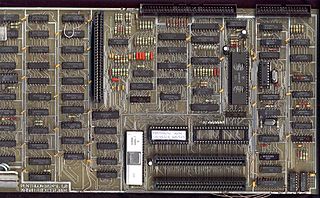
The Pentagon home computer was a clone of the British-made Sinclair ZX Spectrum 128. It was manufactured by amateurs in the former Soviet Union, following freely distributable documentation. Its PCB was copied all over the ex-USSR in 1991-1996, which made it a widespread ZX Spectrum clone. The name "Pentagon" derives from the shape of the original PCB, with a diagonal cut in one of the corners.

The SAM Coupé is an 8-bit British home computer that was first released in late 1989. It was based on and designed to have compatibility with the ZX Spectrum 48K and marketed as a logical upgrade from the Spectrum. It was originally manufactured by Miles Gordon Technology (MGT), based in Swansea in the United Kingdom.

The Enterprise is a Zilog Z80-based home computer announced in 1983, but through a series of delays, not commercially available until 1985. The specification as released was powerful and one of the higher end in its class. This was due to the use of ASICs for graphics and sound which took workload away from the CPU, an extensive implementation of ANSI BASIC and a bank switching system to allow for larger amounts of RAM than the Z80 natively supported. It also featured a distinctive and colourful case design, and promise of multiple expansion options. Ultimately it was not commercially successful, after multiple renames, delays and a changing market place. Its manufacturer calling in the receivers in 1986 with significant debt. It was developed by British company Intelligent Software and marketed by Enterprise Computers. Its two variants are the Enterprise 64, with 64 kilobytes of Random Access Memory (RAM), and the Enterprise 128, with 128 KB of RAM.
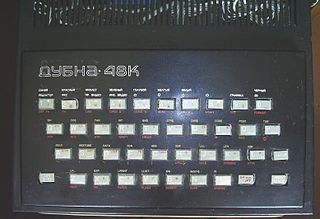
The Dubna 48K is a Soviet clone of the ZX Spectrum home computer launched in 1991. It was based on an analogue of the Zilog Z80 microprocessor. Its name comes from Dubna, a town near Moscow, where it was produced on the "TENSOR" instrument factory, and "48K" stands for 48 KBs of RAM.

The ATM Turbo, also known simply as ATM is a ZX Spectrum clone, developed in Moscow in 1991, by two firms, MicroArt and ATM. It offers enhanced characteristics, compared to the original Spectrum, such as a Z80 at 7 MHz, 1024 kB RAM, 128 kB ROM, AY-8910, 8-bit DAC, 8-bit 8-channel ADC, RS-232, Centronics, Beta Disk Interface, IDE interface, AT/XT keyboard, text mode, and three new graphics modes.
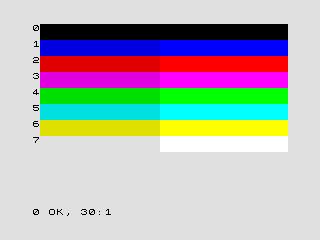
The ZX Spectrum is generally considered to have limited graphical capabilities in comparison to some other home computers of the same era such as the Commodore 64, largely due to its lack of a dedicated graphics chip. Nevertheless, throughout its commercial life and later activity on the demoscene, various techniques have been developed to provide improvements to the Spectrum's graphical output.
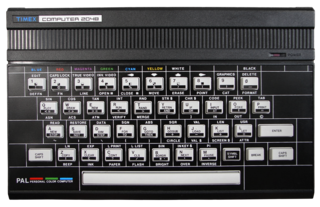
The Timex Computer 2048 or TC 2048 is a 1984 computer developed by Timex Portugal, at the time part of Timex Sinclair. It was based on the Timex Sinclair 2048 prototype, with a similar redesign case, composite video output, Kempston joystick interface, and additional video modes, while being highly compatible with the Sinclair ZX Spectrum computer.
iS-DOS is a disk operating system (DOS) for Soviet/Russian ZX Spectrum clones. iS-DOS was developed in 1990 or 1991, by Iskra Soft, in Leningrad, Soviet Union, now Saint Petersburg, Russia.
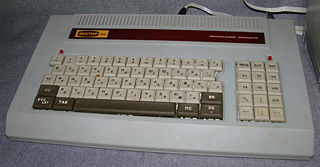
Vector-06C is a home computer with unique graphics capabilities that was designed and mass-produced in USSR in the late 1980s.
The Kay 1024 was a Russian ZX Spectrum clone introduced in 1998. Created by the NEMO company of St. Petersburg, it has 1024 KB of RAM. It was a rival to Scorpion ZS 256, having a slightly lower price. It offered a controller for a PC keyboard and HDD, but not for floppy disks. Adding a General Sound card was easy, and the CPU had a 7 Mhz turbo mode.

The Orion-128 is a DIY computer designed in Soviet Union. It was featured in the Radio magazine in 1990, other materials for the computer were published until 1996. It was the last Intel 8080-based DIY computer in Russia.

The Scorpion ZS-256 was a very widespread ZX Spectrum clone produced in St. Petersburg by Sergey Zonov.











